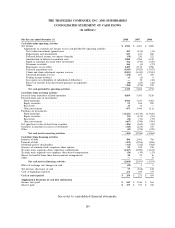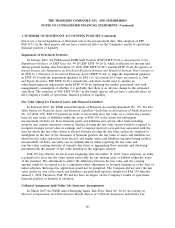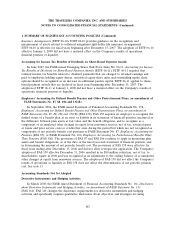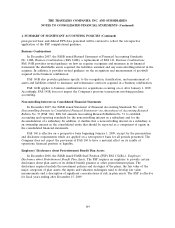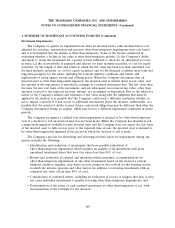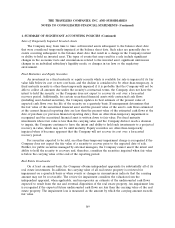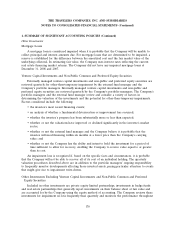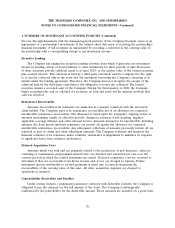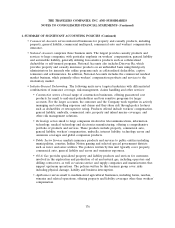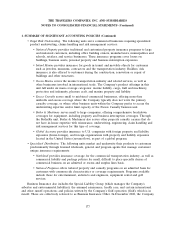Travelers 2008 Annual Report Download - page 181
Download and view the complete annual report
Please find page 181 of the 2008 Travelers annual report below. You can navigate through the pages in the report by either clicking on the pages listed below, or by using the keyword search tool below to find specific information within the annual report.THE TRAVELERS COMPANIES, INC. AND SUBSIDIARIES
NOTES TO CONSOLIDATED FINANCIAL STATEMENTS (Continued)
1. SUMMARY OF SIGNIFICANT ACCOUNTING POLICIES (Continued)
Sales of Temporarily Impaired Invested Assets
The Company may, from time to time, sell invested assets subsequent to the balance sheet date
that were considered temporarily impaired at the balance sheet date. Such sales are generally due to
events occurring subsequent to the balance sheet date that result in a change in the Company’s intent
or ability to hold an invested asset. The types of events that may result in a sale include significant
changes in the economic facts and circumstances related to the invested asset, significant unforeseen
changes in an individual subsidiary’s liquidity needs, or changes in tax laws or the regulatory
environment.
Fixed Maturities and Equity Securities
An investment in a fixed maturity or equity security which is available for sale is impaired if its fair
value falls below its cost or new cost basis, and the decline is considered to be other-than-temporary. A
fixed maturity security is other-than-temporarily impaired if it is probable that the Company will not be
able to collect all amounts due under the security’s contractual terms, the Company does not have the
intent to hold the security, or the Company does not expect to recover its cost over a forecasted
recovery period. Additionally, for certain securitized financial assets with contractual cash flows
(including asset-backed securities), the Company updates its best estimate of the present value of
expected cash flows over the life of the security on a quarterly basis. If management determines that
the fair value of the securitized financial asset and the present value of the asset’s cash flows estimated
at the current financial reporting date are less than the present value of the estimated cash flows at the
date of purchase (or previous financial reporting date), then an other-than-temporary impairment is
recognized and the securitized financial asset is written down to fair value. For fixed maturity
investments where fair value is less than the carrying value and the Company did not reach a decision
to impair, the Company continues to have the intent and ability to hold such investments to a projected
recovery in value, which may not be until maturity. Equity securities are other-than-temporarily
impaired when it becomes apparent that the Company will not recover its cost over a forecasted
recovery period.
For securities expected to be sold, an other-than-temporary impairment charge is recognized if the
Company does not expect the fair value of a security to recover prior to the expected date of sale.
Further, for public securities managed by external managers, the Company cannot assert the intent and
ability to hold the security to recovery and, therefore, considers the securities impaired when fair value
is below the carrying value at the end of the reporting period.
Real Estate Investments
On at least an annual basis, the Company obtains independent appraisals for substantially all of its
real estate investments. In addition, the carrying value of all real estate property is reviewed for
impairment on a quarterly basis or when events or changes in circumstances indicate that the carrying
amount may not be recoverable. The review for impairment considers the valuation from the
independent appraisal, when applicable, and incorporates an estimate of the undiscounted cash flows
expected to result from the use and eventual disposition of the real estate property. An impairment loss
is recognized if the expected future undiscounted cash flows are less than the carrying value of the real
estate property. The impairment loss is measured as the amount by which the carrying amount exceeds
fair value.
169


